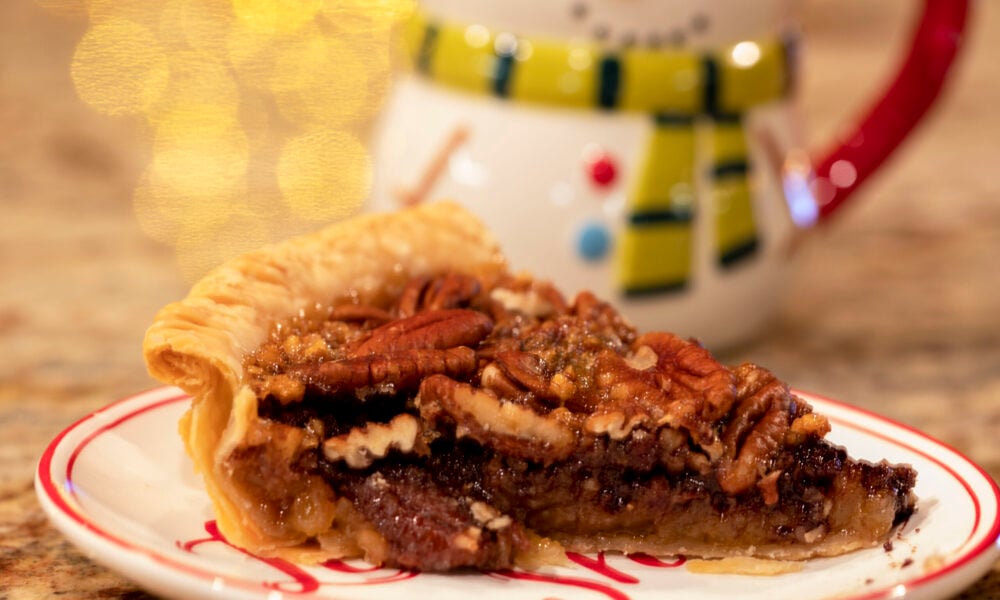This time of year, the air is scented with cinnamon and nutmeg. Whatever you’re celebrating this season, baking is likely a part of it. And that may mean you stocked up recently, as I did, on ingredients like flour, sugar and other sweeteners, and nuts. But how much do you know about the sustainability of nuts and other items in the supermarket baking aisle, and by extension, your favorite holiday cookies or pies? Having recently decided to bake a pecan pie for a gathering with friends, I went down a bit of a rabbit hole on this topic, and I’m here to share what I learned . . . and a recipe.
Nuts are thirsty crops
Much has been written about the water demand of almonds. But nuts are big water users in general. One reason is that nuts like almonds, pecans, pistachios, and walnuts grow on trees that take years to mature. A young almond tree doesn’t begin to produce nuts until its third or fourth year, and other varieties typically take even longer. Many nut trees, particularly pistachios, are also alternate bearing, meaning a large harvest one year is followed by a lighter harvest the next. But whether a tree is producing nuts or not, it needs water to live and grow.
This is a problem because US tree nut production today is concentrated in California—the state grows 80 percent of the world’s almonds—and a few other western states that are facing a growing water crisis. The region is in the middle of the worst drought in 1,200 years, and though the rainy season has begun and there is hope that the current weather pattern will ease this spring, continuing climate change will likely bring repeated severe drought to the West, raising questions about the future of nut production in the region.
While some California growers are pulling up nut trees in the face of drought, data show that the state’s almond and pistachio industries have actually expanded in recent years, using critical water supplies to turn big profits at the expense of local communities.
So as someone who adds nuts to my morning yogurt parfait and believes walnuts are mandatory in banana bread and chocolate chip cookies (fight me!), I’ve been looking for more sustainable alternatives.
Pe-can we fight drought with better nuts?
Pecans present an interesting alternative nut. While grown today in some arid western states, the pecan tree is native to the southern United States and thrives in more humid climates. (Read this fascinating account of the tree’s domestication, which involves work by a 19th century enslaved gardener on a Louisiana plantation.)
Pecans are thirsty and grown commercially in states that see substantially more rainfall than the West. In 2020 (the last year the USDA released detailed information on US pecan production), Georgia ranked first in pecan acres, followed by Texas. For my holiday pie, I sought out Georgia pecans. There may also be other good replacements for the California-grown almonds, pistachios, and walnuts I used to stock in my pantry.
Scientists at New Mexico State University are working to breed pecan trees adapted to the changing climate, and other researchers are looking for ways to grow nuts more sustainably, as in agroforestry systems that incorporate fruit, nut, or other trees and shrubs into crop and livestock systems. Such systems mimic natural ecosystems and can provide a range of benefits, including pollinator habitat, improved soil health, and economic diversification for farmers. Hazelnuts may be another good candidate for expansion in sustainable agriculture systems in various regions. They grow on shrubs rather than trees and are drought-tolerant, and scientists are working to breed fungus-resistant varieties that can grow in New Jersey. Other research teams see hazelnuts as a way to diversify Upper Midwest farming systems and create new opportunities for farmers in Minnesota and Wisconsin.
Back to my pie, and all that corn
If you’re thinking, “Wait, what does corn have to do with pecan pie?,” I’ve got news for you: there’s a lot of corn in most pecan pies. My friend Nancy makes a delicious one, and she was nice enough to send me the recipe. But as soon as I read it, I knew I’d try to adapt it. Its gooey filling is based on corn syrup, and corn—by far the largest US agricultural crop—has myriad environmental problems, including drawing down critical groundwater supplies.
Then I read this fascinating article about how the makers of Karo Corn Syrup invented the modern, achingly sweet pecan pie. And that sent me on a hunt for the original pecan pie base: sorghum syrup. Because this is a post about nuts, I won’t do a deep dive on sorghum, a grain crop most people in the United States have never heard of, even though it’s an important food crop globally and is having something of a revival in this country. It’s also drought-tolerant and gluten-free, and apparently pops like popcorn.
Presenting a (more) sustainable holiday pie
Armed with all this knowledge, a big bag of Georgia pecans, and a jar of sorghum syrup, I made a pie last weekend and took it to dinner at the home of some dear friends, where I served it up with freshly whipped organic cream. It was different from the pie we were all used to, the flavor of the sorghum more like molasses than Karo. But it was good, and this whole exercise taught me a lot.
So without further ado, the recipe:

Sorghum-Bourbon Pecan Pie
Adapted from the Washington Post’s sorghum pecan pie (2006).
Ingredients:
- A single-crust batch of your favorite pie dough, refrigerated at least 2 hours or overnight (I like Smitten Kitchen’s all-butter, really flaky pie dough)
- 1/3 cup firmly packed dark brown sugar
- 3 large eggs, lightly beaten
- 1/2 stick (4 tablespoons) unsalted butter, softened
- 1 tablespoon cornstarch
- 1/4 teaspoon kosher salt
- 3/4 cup sorghum syrup (may substitute molasses)
- 1 tablespoon bourbon
- 1/4 teaspoon orange zest
- 1 1/2 cups coarsely chopped pecans
Directions:
Using a rolling pin, roll out the dough on a well-floured work surface to a 12-inch round. Transfer to a 9-inch pie pan, folding up any excess dough that hangs below the rim so that you have enough material to crimp the edges. Cover and refrigerate for at least 15 minutes and up to a few hours.
When ready to bake, preheat the oven to 325 degrees. Lightly press a sheet of parchment paper over the pie shell and scatter pie weights or dried beans on the bottom. Bake on the middle oven rack for 13 to 15 minutes. Remove the parchment and pie weights, prick the bottom of the crust with a fork, and return to bake for another 10 minutes. Cool to room temperature before filling.
When ready to fill and bake the pie, preheat the oven to 375 degrees.
In a large bowl, using a hand mixer on low speed, beat the brown sugar and butter for about 1 1/2 minutes or until incorporated. Add the eggs one at a time, beating in between, then add the cornstarch, salt, and sorghum syrup and beat until thoroughly combined. Scatter the pecans across the bottom of the pre-baked pie crust and pour the filling over. Arrange a few pecan halves on top if you like. Bake for 35 to 40 minutes or until the center has risen and jiggles slightly, then cool on a wire rack for at least 1 hour. Serve warm or at room temperature, with whipped cream if desired.
Happy holidays!

